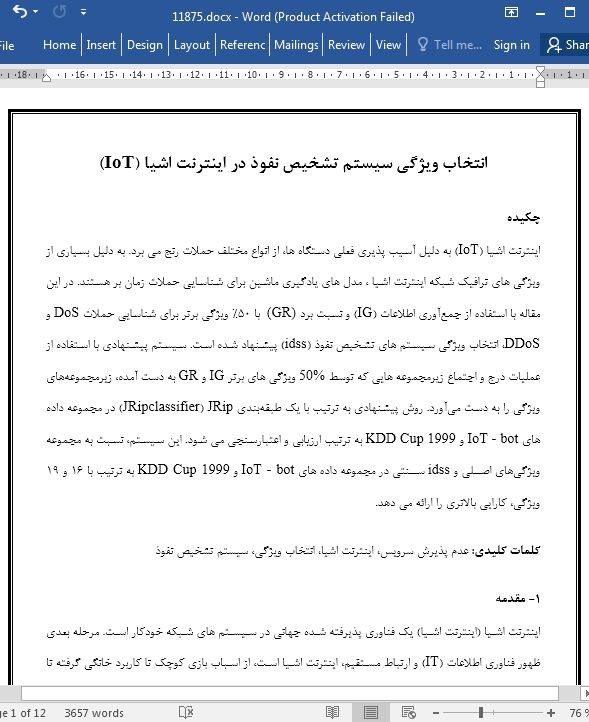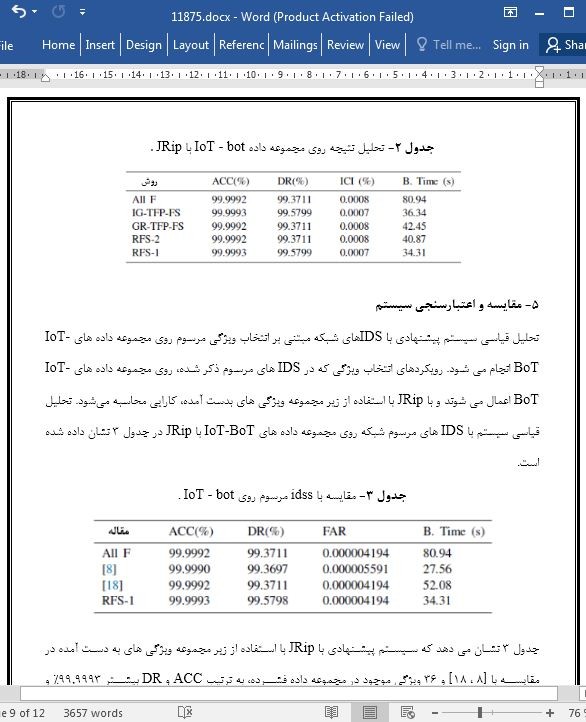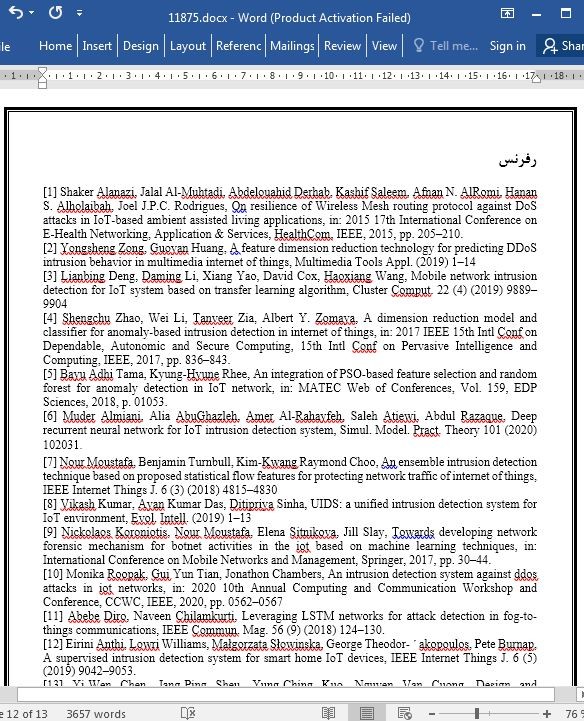
انتخاب ویژگی سیستم تشخیص نفوذ در اینترنت اشیا (IoT)
چکیده
اینترنت اشیا (IoT) به دلیل آسیب پذیری فعلی دستگاه ها، از انواع مختلف حملات رنج می برد. به دلیل بسیاری از ویژگی های ترافیک شبکه اینترنت اشیا ، مدل های یادگیری ماشین برای شناسایی حملات زمان بر هستند. در این مقاله با استفاده از جمعآوری اطلاعات (IG) و نسبت برد (GR) با 50٪ ویژگی برتر برای شناسایی حملات DoS و DDoS، انتخاب ویژگی سیستم های تشخیص نفوذ (idss) پیشنهاد شده است. سیستم پیشنهادی با استفاده از عملیات درج و اجتماع زیرمجموعه هایی که توسط 50% ویژگی های برتر IG و GR به دست آمده، زیرمجموعههای ویژگی را به دست میآورد. روش پیشنهادی به ترتیب با یک طبقهبندی JRip (JRipclassifier) در مجموعه داده های IoT - bot و KDD Cup 1999 به ترتیب ارزیابی و اعتبارسنجی می شود. این سیستم، نسبت به مجموعه ویژگیهای اصلی و idss سنتی در مجموعه داده های IoT - bot و KDD Cup 1999 به ترتیب با 16 و 19 ویژگی، کارایی بالاتری را ارائه می دهد.
1- مقدمه
اینترنت اشیا (اینترنت اشیا) یک فناوری پذیرفته شده جهانی در سیستم های شبکه خودکار است. مرحله بعدی ظهور فناوری اطلاعات (IT) و ارتباط مستقیم، اینترنت اشیا است، از اسباب بازی کوچک تا کاربرد خانگی گرفته تا شهر هوشمند اینترنت اشیا. IoT ترکیبی از سیستم های جاسازی شده متصل به ابر است که برای دسترسی به سرویسهای مرتبط با IT که از ترکیبی از اشیای الکترونیکی و پروتکل اینترنت استفاده میکند، توسط مشتری به کارگرفته میشود.
Abstract
Internet of Things (IoT) is suffered from different types of attacks due to vulnerability present in devices. Due to many IoT network traffic features, the machine learning models take time to detect attacks. This paper proposes a feature selection for intrusion detection systems (IDSs) using Information Gain (IG) and Gain Ratio (GR) with the ranked top 50% features for the detection of DoS and DDoS attacks. The proposed system obtains feature subsets using insertion and union operations on subsets obtained by the ranked top 50% IG and GR features. The proposed method is evaluated and validated on IoT-BoT and KDD Cup 1999 datasets, respectively, with a JRipclassifier. The system provides higher performance than the original feature set and traditional IDSs on IoT-BoT and KDD Cup 1999 datasets using 16 and 19 features, respectively.
1. Introduction
Internet of Things (IoT) is a globally adopted technology in automated network systems. The next stage of the Information Technology (IT) rising and interconnectivity is the IoT, from little toy to homemade application to the smart city in IoT. IoT is a mixture of cloud-connected embedded systems used by the consumer to access IT-related services utilizing the combination of electronics-related things and internet protocol.
چکیده
1- مقدمه
2- بررسی مقالات
3- سیستم پیشنهادی
4- پیاده سازی سیستم و تحلیل نتیجه
5- مقایسه و اعتبارسنجی سیستم
6- نتیجه گیری
منابع
Abstract
1. Introduction
2. Literature review
3. Proposed system
4. System implementation and result analysis
5. System comparison and validation
6. Conclusion
References
- اصل مقاله انگلیسی با فرمت ورد (word) با قابلیت ویرایش
- ترجمه فارسی مقاله با فرمت ورد (word) با قابلیت ویرایش، بدون آرم سایت ای ترجمه
- ترجمه فارسی مقاله با فرمت pdf، بدون آرم سایت ای ترجمه



